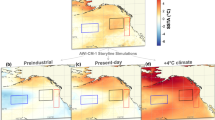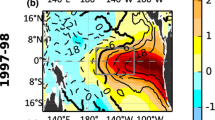Abstract
Marine heat waves along the Western Australian coast are potentially damaging to the marine environment especially coastal fisheries and the Ningaloo Reef. Initiation and amplification mechanisms for marine heat waves (referred to as ‘Ningaloo Niño’ events) are explored using ocean and atmosphere reanalyses for the period 1960–2011. We find that the onset stage from October to November is promoted by wind-evaporation-SST feedback that operates to the northwest of the coast on the north-eastern flank of the Mascarene subtropical high: cyclonic anomalies act to reduce the surface wind speed and warm the ocean surface, thereby driving increased rainfall and stronger cyclonic anomalies. The growth and southward expansion of positive SST anomalies along the Australian west coast is further supplemented by anomalous poleward advection of heat by the Leeuwin Current, which is coupled with the cyclonic anomalies off the coast. The strongest Ningaloo Niño events, such as the record strong 2011 event, occur in conjunction with La Niña conditions in the Pacific, which drives westerly wind anomalies to the northwest of Australia that can promote the WES feedback and accelerate the Leeuwin Current via transmission of thermocline anomalies from the western Pacific onto the west Australian coast. However, many Ningaloo Niño events occur independent of La Niña and some Ningaloo Niño events even occur during certain El Niños. We explain this general independence from ENSO because the triggering of Ningaloo Niño events from the Pacific is most sensitive to antecedent SST anomalies in the far western Pacific, rather than in the central Pacific where ENSO typically has greatest magnitude.












Similar content being viewed by others
Notes
ENSO years are identified using the Niño Index, based on SST anomalies in the Niño 3.4 region, provided by the Climate Prediction Center at http://www.cpc.ncep.noaa.gov/products/analysis_monitoring/ensostuff/ensoyears_1971-2000_climo.shtml.
References
Alexander MA, Blade I, Newman M, Lanzante JR, Lau N-C (2002) The atmospheric bridge: the influence of ENSO teleconnections on air–sea interaction over the global oceans. J Clim 15:2205–2231
Benthuysen J, Feng M, Zhong L (2014) Spatial patterns of warming off Western Australia during the 2011 Ningaloo Niño: quantifying impacts of remote and local forcing. Cont Shelf Res 91:232–246
Clarke AJ, Liu X (1994) Interannual sea level in the northern and eastern Indian Ocean. J Phys Oceanogr 24:1224–1235
Dee DP, Uppala SM, Simmons AJ, Berrisford P, Poli P, Kobayashi S, Andrae U, Balmeseda MA, Balsamo G, Bauer P, Bechtold P, Beljaars ACM, van de Berg L, Bidlot J, Bormann N, Delsol C, Dragani R, Fuentes M, Geer AJ, Haimberger L, Healy SB, Hersbach H, Hólm EV, Isaksen L, Kållberg P, Köhler M, Matricardi M, McNally AP, Monge-Sanz BM, Morcrette J-J, Park B-K, Peubey C, de Rosnay P, Tavolato C, Thépaut J-N, Virart F (2011) The Era-Interim reanalysis: configuration and performance of the data assimilation system. Q J R Meteorol Soc 137:553–597
Depczynski M, Gilmour JP, Ridgway T, Barnes H, Heyward AJ, Holmes TH, Moore JAY, Radford BT, Thomson DP, Tinkler P, Wilson SK (2013) Bleaching, coral mortality and subsequent survivorship on a West Australian fringing reef. Coral Reefs. doi:10.1007/s00338-012-0974-0
Doi T, Behera SK, Yamagata T (2013) Predictability of the Ningaloo Niño/Niña. Sci Rep 3:2892
Feng M, Meyers G, Pearce A, Wijffels S (2003) Annual and interannual variations of the Leeuwin Current at 32°S. J Geophys Res 108:33–55
Feng M, McPhaden MJ, Xie S, Hafner J (2013) La Niña forces unprecedented Leeuwin Current warming in 2011. Sci Rep 3:1277. doi:10.1038/srep01277
Feng M, Hendon HH, Xie S-P, Marshall AG, Schiller A, Kosaka Y, Caputi N, Pearce A (2015) Decadal increase in Ningaloo Niño since the late 1990s. Geophys Res Lett 42. doi:10.1002/2014GL062509
Gill AE (1980) Some simple solutions for heat-induced tropical circulation. Q J R Meteorol Soc 106:447–462
Hendon HH (2003) Indonesian rainfall variability: impacts of ENSO and local air–sea interaction. J Clim 16:1775–1790
Hendon HH, Wang G (2009) Seasonal prediction of the Leeuwin Current using the POAMA dynamical seasonal forecast model. Clim Dyn 34:1129–1137
Jones DA, Wang W, Fawcett R (2009) High-quality spatial climate data-sets for Australia. Aust Meteorol Oceanogr J 58:233–248
Kalnay E, Kanamitsu M, Kistler R, Collins W, Deaven D, Gandin L, Iredell M, Saha S, White G, Woollen J, Zhu Y, Leetmaa A, Reynolds B, Chelliah M, Ebisuzaki W, Higgins W, Janowiak J, Mo KC, Ropelewski C, Wang J, Jenne R, Joseph D (1996) The NCEP/NCAR 40-year reanalysis project. Bull Am Meteorol Soc 77:437–471
Kataoka T, Tozuka T, Behera S, Yamagata T (2014) On the Ningaloo Niño/Niña. Clim Dyn 43:1463–1482
Madden RA, Julian PR (1971) Detection of a 40–50 day oscillation in the zonal wind in the tropical Pacific. J Atmos Sci 28:702–708
Madden RA, Julian PR (1972) Description of global-scale circulation cells in the tropics with a 40250 day period. J Atmos Sci 29:1109–1123
Marshall AG, Hendon HH (2014) Impacts of the MJO in the Indian Ocean and on the Western Australian coast. Clim Dyn 42:579–595
Meyers G (1996) Variation of the Indonesian throughflow and the El Niño-Southern Oscillation. J Geophys Res 101:12255–12263
Nicholls N (1979) A simple air–sea interaction model. Q J R Meteorol Soc 107:1221–1224
Oke P, Sakov P, Cahill ML, Dunn J, Fiedler R, Griffin DA, Mansbridge JV, Ridgway K, Schiller A (2013) Towards a dynamically balanced eddy-resolving reanalysis: BRAN3. Ocean Model 67:52–70
Pearce AF (1997) The Leeuwin Current and the Houtman Abrolhos Islands, Western Australia. In: Wells FE (ed) The Marine Flora and Fauna of the Houtman Abrolhos Islands, Western Australia, vol 1. Western Australian Museum, Perth, pp 11–46
Pearce AF, Feng M (2013) The rise and fall of the “marine heat wave” off Western Australia during the summer of 2010/2011. J Mar Syst 111–112:139–156
Pearce AF, Phillips BF (1988) ENSO events, the Leeuwin Current and larval recruitment of the western rock lobster. J Conserv Int Explor Mer 45:13–21
Reynolds RW, Rayner NA, Smith TM, Stokes DC, Wang W (2002) An improved in situ and satellite SST analysis for climate. J Clim 15:1609–1625
Schwarzkopf F, Boning C (2011) Contribution of Pacific wind stress to multi-decadal variations in upper-ocean heat content and sea level in the tropical south Indian Ocean. Geophys Res Lett 38:L12602. doi:10.1029/2011GL047651
Shinoda T, Alexander MA, Hendon HH (2004) Remote response of the Indian Ocean to interannual SST variations in the tropical Pacific. J Clim 17:362–372
Smith RL, Huyer A, Godfrey JS, Church J (1991) The Leeuwin Current off Western Australia, 1986–1987. J Phys Oceanogr 21:323–345
Smith TM, Reynolds RW, Peterson TC, Lawrimore J (2008) Improvements to NOAA’s historical merged land–ocean surface temperature analysis (1880–2006). J Clim 21:2283–2296
Student (1908) The probable error of a mean. Biometrika 6:1–25
Tozuka T, Kataoka T, Yamagata T (2014) Locally and remotely forced atmospheric circulation anomalies of Ningaloo Niño/Niña. Clim Dyn. doi:10.1007/s00382-013-2044-x
Uppala SM, Kallberg PW, Simmons AJ, Andrae U, Da Costa Bechtold V, Fiorino M, Gibson JK, Haseler J, Hernandez A, Kelly GA (2005) The ERA-40 re-analysis. Q J R Meteorol Soc 131:2961–3012
Xie S-P, Philander SGH (1994) A coupled ocean-atmosphere model of relevance to the ITCZ in the eastern Pacific. Tellus A 46:340–350
Xue Y, Balmaseda MA, Boyer T, Ferry N, Good S, Ishikawa I, Rienecker M, Rosati T, Yin Y, Kumar A (2011) Comparative analysis of upper ocean heat content variability from ensemble operational ocean analyses. US CLIVAR Var 9:7–10
Yin Y, Alves O, Oke PR (2011) An ensemble ocean data assimilation system for seasonal prediction. Mon Weather Rev 139:786–808
Zinke J, Rountrey A, Feng M, Xie S-P, Dissard D, Rankenburg K, Lough JM, McCulloch MT (2014) Corals record long-term Leeuwin current variability including Ningaloo Niño/Niña since 1795. Nat Commun 5:3607. doi:10.1038/ncomms4607
Acknowledgments
Support for this work was provided by the Australian Climate Change Science Program (ACCSP). The eddy-permitting ocean reanalysis (BRAN3.5) was created as part of the BLUElink partnership project between CSIRO, the Bureau of Meteorology and the Royal Australian Navy. We thank Drs. Claire Spillman, Li Shi and Gary Meyers for reviewing earlier versions of this manuscript, and the two anonymous journal reviewers for their insightful comments and suggestions.
Author information
Authors and Affiliations
Corresponding author
Rights and permissions
About this article
Cite this article
Marshall, A.G., Hendon, H.H., Feng, M. et al. Initiation and amplification of the Ningaloo Niño. Clim Dyn 45, 2367–2385 (2015). https://doi.org/10.1007/s00382-015-2477-5
Received:
Accepted:
Published:
Issue Date:
DOI: https://doi.org/10.1007/s00382-015-2477-5




